Not very popular among travelers but very much worth the visit, Padua (or Padova in Italian) is a lovely Italian city in the province of Veneto that just waits for you to discover it. Overshadowed most of the times by places like Venice or Florence, Padua will surprise the visitor with its numerous attractions, some of which rated as UNESCO World Heritage Sites. Read further to find out what are the best things to do in Padua.
Contents
- How to get to Padua?
- What is Padua famous for?
- Is Padua worth visiting?
- How many days to stay in Padua?
- Best things to do in Padua
- 1. Marvel Giotto’s frescoes at the Scrovegni Chapel
- 2. Visit Orto Botanico – the oldest botanical garden in the world
- 3. Admire the grand Basilica of St. Anthony of Padua (Il Santo)
- 4. See Padua Cathedral (Il Duomo)
- 5. Visit the Diocesan Museum of Padua (Museo diocesano) and the Baptistery (Il Battistero)
- 6. Visit Padua’s 800-year old market
- 7. Enjoy a dinner at Piazza dei Signori with a view of the Astronomical Clock
- 8. Walk around Prato della Valle
- 9. Count the stars at La Specola
- 10. Indulge in some shopping in Padua
- 11. Cruise the Brenta Canal with Il Burchiello
- 12. Visit Palazzo Zuckermann and its 2 museums
- 13. See the treasures kept at the Eremitani Museums
- 14. See the Church of the Eremitani
- 15. Marvel Palazzo della Ragione
- 16. Visit the Basilica of St. Giustina
- 17. Enjoy a cup of coffee and a lesson in history at Pedrocchi Café
- 18. Get a sense of Padua as a university city at Palazzo Bo
DISCLOSURE: This post contains affiliate links. If you make a purchase via one of those links, I will earn a commission at no extra cost for you.

How to get to Padua?
It’s quite easy to travel to Padua. You can fly either to the Marco Polo Airport of Venice or to the airport of Treviso and then take the public transport to Padua. I flew to Treviso and had a private taxi arranged via my accommodation to pick me up at the airport, which was quite convenient and absolutely not expensive even if you travel on a budget.
If you fly into Treviso, there is a direct bus from the airport (line 101) to Padua. The journey takes about hour and a half. If you fly into Marco Polo Airport, you can get to Mestre and then take the train or the bus (line 15) to Padua, and all this in about an hour.
Pro tip: Check out on Omio.com for all transportation options (flights, buses or trains) to and from Padua.
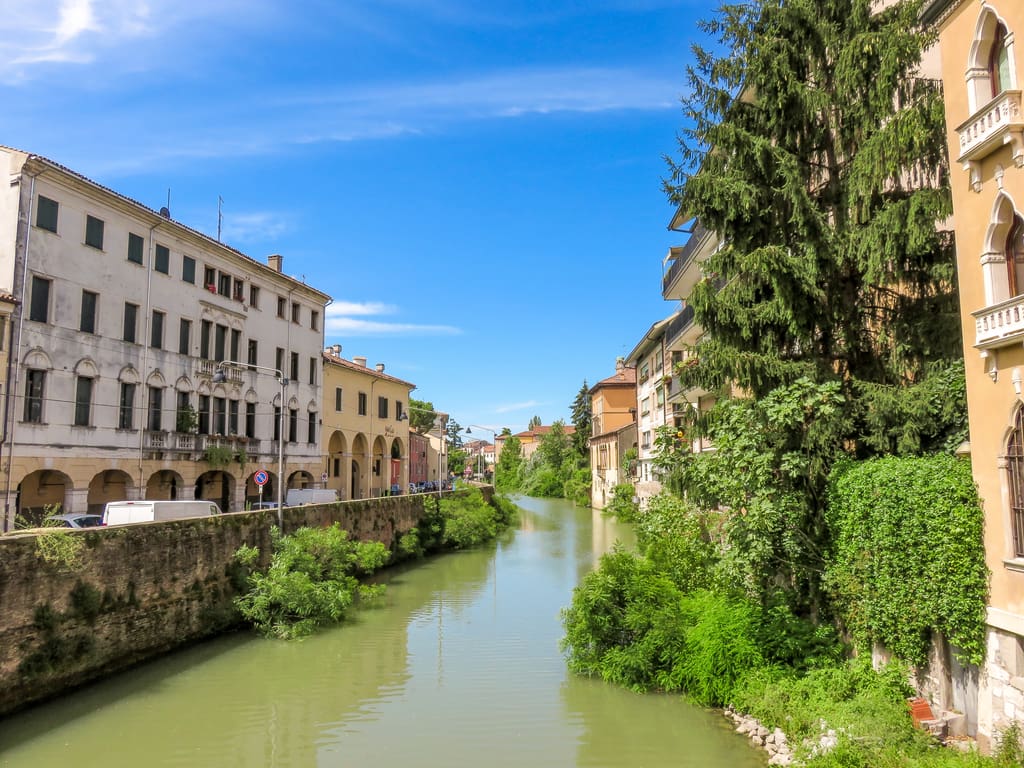
What is Padua famous for?
Padua is one of the cradles of the Italian Renaissance. The 14th-century frescoes and the Botanical Garden, both UNESCO World Heritage Sites, are the most popular things to see in Padua. Padua is also famous for Il Santo, or Saint Anthony of Padua, the Franciscan friar who settled in Padua. The University of Padua is the second oldest in Italy (established in 1222).
Is Padua worth visiting?
Absolutely! Padua is a city with rich historical and cultural heritage, full of charm, that remains a bit off-the-beaten track. In Padua, you can savor Italy at its best without the crowds and the overtourism, which are typical for cities like Florence or Venice.
Besides, Padua does not only offer a fine combination of art, history, and culture, but also a whole lot of lovely shops, scattered around the historical center, which will satisfy every fashion buff.
How many days to stay in Padua?
If you want to see all attractions in Padua you should consider staying at least a week in Padua. A couple of days won’t be enough to see all museums and do all those fun things in Padua. I stayed 4 days in Padua and I feel they were not enough, so I’ll be visiting the city for sure once again. You can read here my 4-day itinerary of Padua.

Best things to do in Padua
Padua is not a place to be visited in a day, as it abounds in things to do and places to see. One of the best things to do in Padua is take a day cruise on the Brenta Canal to Venice, just like this has be done in the days of the Grand Tour. Other best things to do in Padua include a visit to Scrovegni Chapel, a food walking tour of the city, and of course a visit to the Basilica of St. Anthony of Padua. Read further to find out my selection of 18 interesting things to do in Padua and places to see in this beautiful Italian city.
On the map below, you can find all attractions in Padua which are mentioned in this travel guide:
1. Marvel Giotto’s frescoes at the Scrovegni Chapel
The Scrovegni Chapel (Cappella degli Scrovegni) is considered the masterpiece of Giotto (1267-1337) – the father of the Italian Renaissance, one of the first painters who diverted from the flat images of the Byzantine painting traditions. Take a good look of the faces, they are so vivid and full of emotions. I must admit I had the impression that Giotto knew quite a lot of beautiful women.
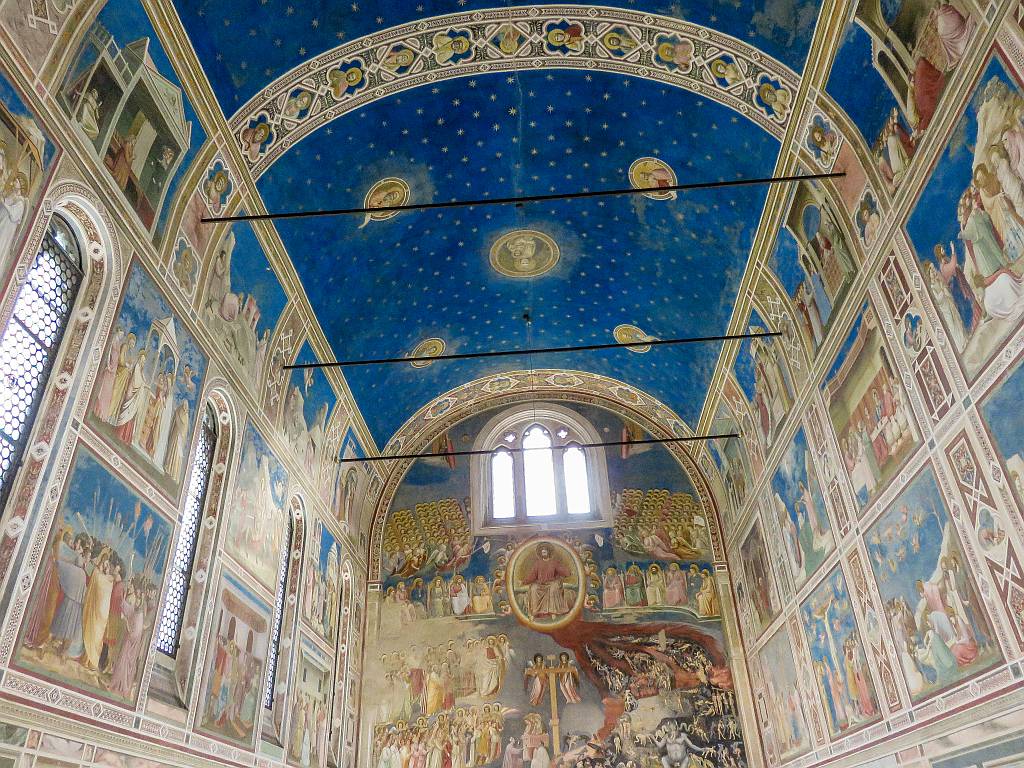
The chapel was built on the remains of a Roman theater by the wealthy banker Enrico Scrovegni and commissioned to Giotto in just after 1300. It was adjacent to a palace, which was demolished in 1827. Luckily, the Municipality of Padua acquired the church so that it could be preserved and we can enjoy the beautiful frescoes inside.

The Scrovegni Chapel (the most famous tourist attraction in Padua) is a good example of how sites of high cultural and historical value are being preserved in a sustainable way. Let’s be straight on this one: we, as tourists, do our utmost to ruin our monuments by loving them too much.
In 2021 UNESCO enlisted The Scrovegni Chapel as a World Heritage Site in 2021 together with seven other sites in Padua under the name of Padua’s fourteenth-century fresco cycles.
Unfortunately, you can’t enjoy the frescoes endlessly, unless you visit the chapel multiple times. You need to book tickets in advance and visitors are allowed in the chapel in small groups for a limited time (about 15 minutes), first having to wait in a climate controlled room. You also can’t make a booking for the same day. You need to arrive well in advance before your time slot, as you first need to spend 5 minutes in the climate controlled room.
Practical info
Address: Piazza Eremitani, 8, Padova 35100
Admission fee: adults – 16 EUR (day ticket, including Eremitani Museum and the Zuckermann Palace), 10 EUR (evening ticket, only the chapel)
Opening times: daily, from 9 am till 7 pm, from March 25 till November 1, daily from 7 am till 10 pm
Website: www.cappelladegliscrovegni.it
2. Visit Orto Botanico – the oldest botanical garden in the world
The Botanical Garden of Padua (Orto Botanico) – one of the most popular attractions in Padua, is the world’s oldest academic botanical garden. It was created in 1545 and was used as a teaching facility of the University of Padua. For its outstanding contribution for the development of modern scientific disciplines like botany, medicine, ecology and pharmacy among others, it has be recognized as a UNESCO World Heritage Site.
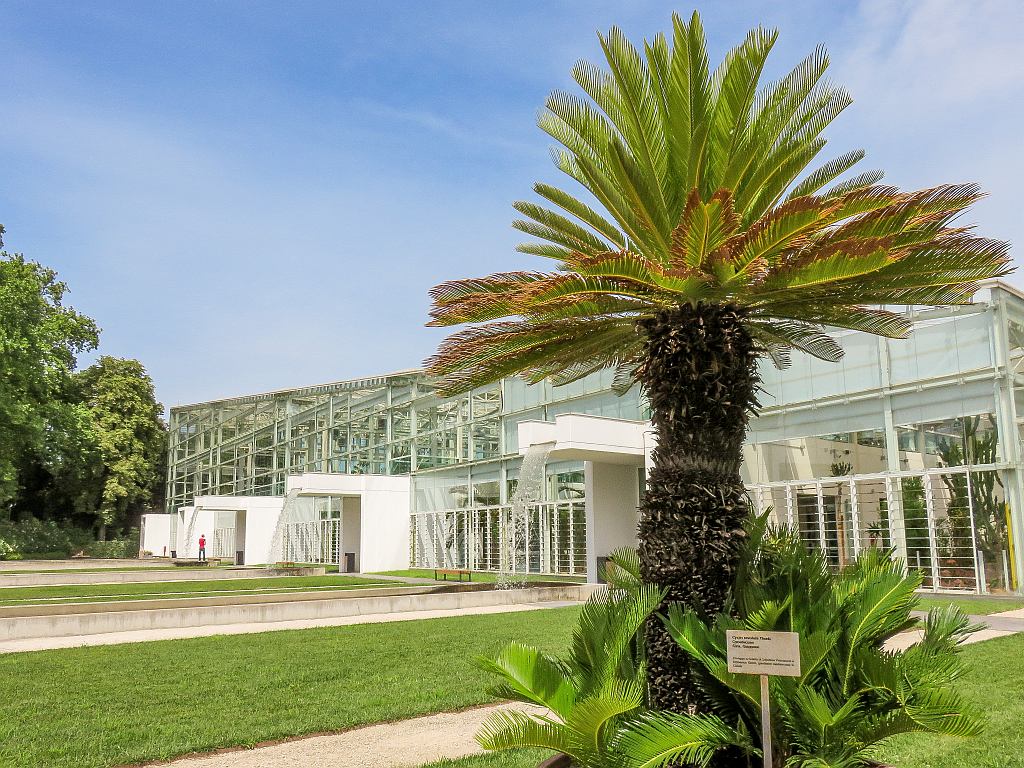
It has a historical garden and a biodiversity garden located in a solar active building. The oldest tree in the garden is the Mediterranean palm planted in 1585.
Practical info
Address: via Orto botanico 15, 35123 Padova
Admission fee: adults – 10 EUR, kids (6-12 yoa) – free of charge, students (13-25 yoa) – 6 EUR
Opening times: closed on Mondays; November-March, from 10 am till 5 pm; April-September, from 10 am till 7 pm; October, from 10 am till 6 pm
Website: www.ortobotanicopd.it
3. Admire the grand Basilica of St. Anthony of Padua (Il Santo)
The name of Saint Anthony is immediately associated with the name of the city, as Saint Anthony is the patron saint of Padua. The Basilica of Saint Anthony forms a large complex together with the Franciscan Friary (a network of 5 cloisters) and the Oratory of Saint George.

The relics of St. Anthony are kept in the Treasury Chapel and the basilica is one of the international shrines of the Roman Catholic Church. Il Santo is a must-see in Padua.

Do not forget to take a break at one of the cafés across the square where you can enjoy a refreshing gelato feasting your eyes on the church, the square and the statue of Gattamelata, cast by Donatello.
Address: Piazza del Santo, 11, 35123 Padova
4. See Padua Cathedral (Il Duomo)
Il Duomo is the cathedral of Padua. It took 200 years (1551-1754) to build it and still has the facade remained unfinished. It has been initially designed by Michelangelo, but later on the designs have been changed.
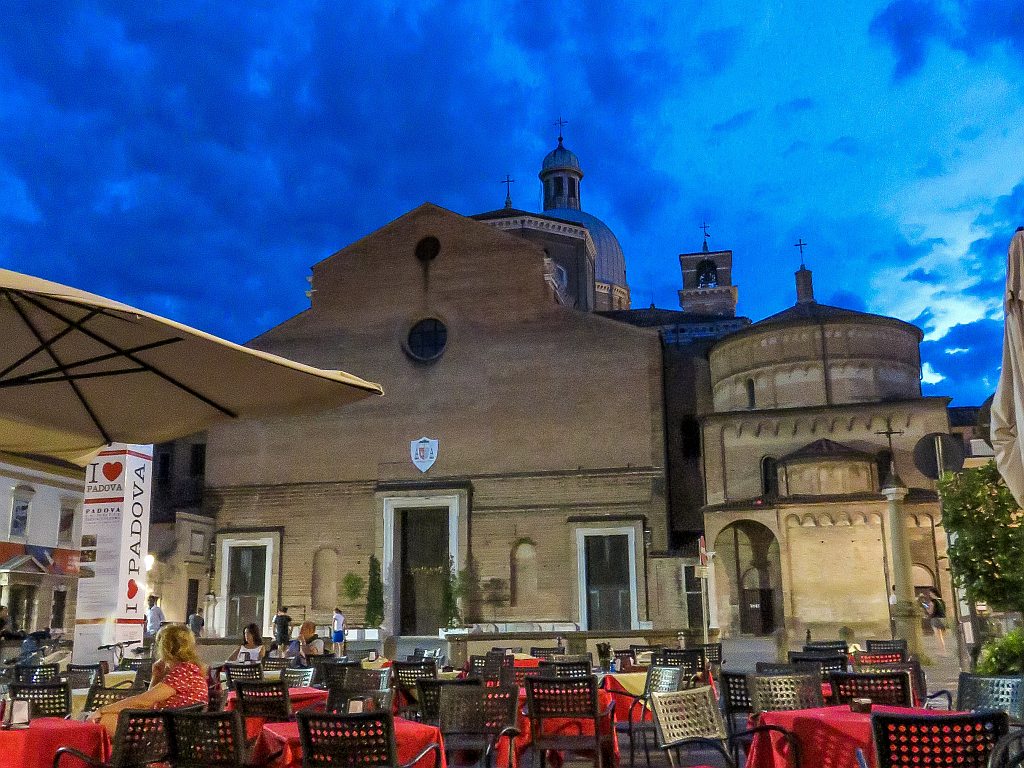
In front of the cathedral is Piazza Duomo, one of Padua’s many squares, where you can sit, relax, and have a drink, or a pizza.
5. Visit the Diocesan Museum of Padua (Museo diocesano) and the Baptistery (Il Battistero)
If you are interested in religious art, right on Piazza Duomo you can visit the Diocesan museum of Padua (Museo diocesano di Padova). It is housed in the former Bishop’s Palace (Palazzo Vescovile). Quite beautiful is the salon which displays portraits of the bishops of Padua.

The Baptistery, located next to the cathedral, was built in the 12th century. The most remarkable thing about the Baptistery is the 14th century fresco cycle by Giusto de’ Menabuoi, one of the forefathers of the Italian Renaissance. The frescoes in the Baptistery are a part of the collective UNESCO World Heritage Site Padua’s fourteenth-century fresco cycles.
You can visit the museum and the Baptistery with a combined ticket.
Practical info
Address: Palazzo Vescovile, Piazza Duomo 12, 35141 Padova
Admission fee: Only museum: adults – 6 EUR, kids (up to 6 yoa) – free of charge, students (7-25 yoa) – 5 EUR; Baptistery+Museum: adults – 12 EUR, kids (up to 6 yoa) – free of charge, students (7-25 yoa) – 9 EUR
Opening times: Monday, from 2 pm till 6 pm, Tuesday-Sunday, 10 am till 1 pm and from 2 pm till 6 pm
Website: museodiocesanopadova.it
6. Visit Padua’s 800-year old market
Farmers’ markets in Italy are an institution. Where else can you find such an explosion of colors, smells and tastes! You can’t visit an Italian city without visiting its farmers’ markets and Padua does not disappoint. 6 days per week the lively squares Piazza delle Erbe and Piazza dei Frutti become the focal point of Padua’s everyday life.
And when you just think you’ve seen it all, venture into Palazzo della Ragione, the old town hall of Padua, where on the ground floor you will find numerous deli shops. The covered market of Padua is 800 years old, which makes it perhaps the oldest, still functioning market in Europe! For sure it is also one of the biggest markets in Italy.
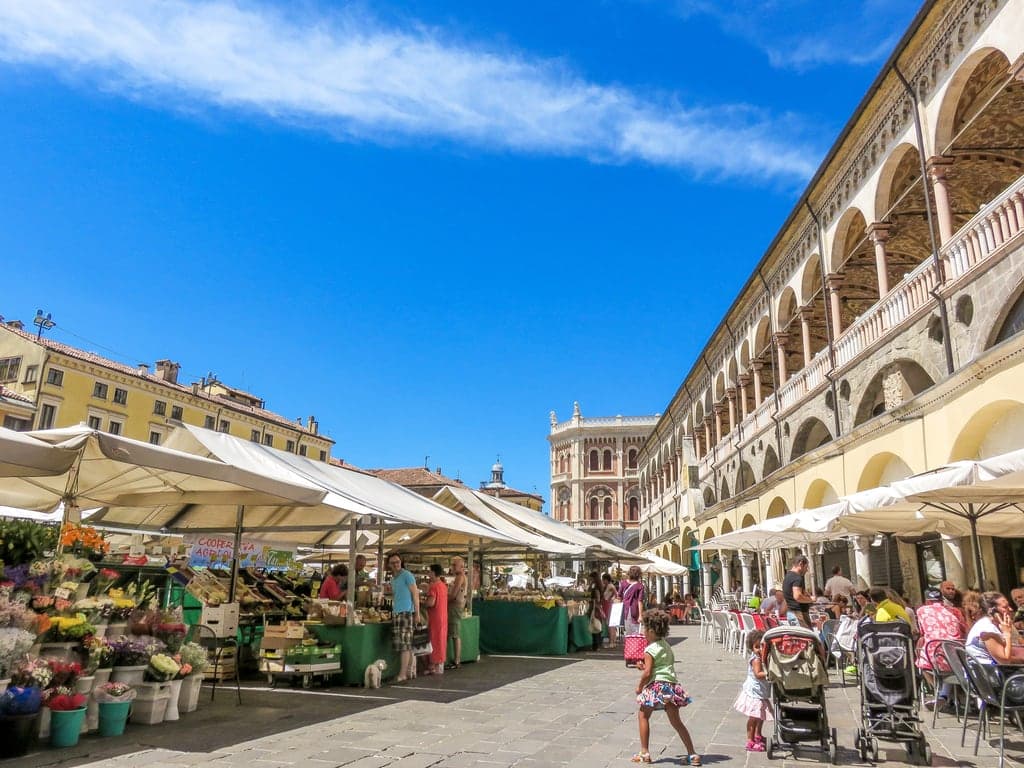
You can book a guided 2-hour market tour in Padua, try some delicious food an learn everything about the tradition of the farmers’ markets in Padua and Italy.
There’s one thing that I regret I couldn’t do in Padua and that is a market tour followed up by a cooking class. Next time I visit Padua, I’ll book for sure one of these two tours I came across: tour 1 of the market followed by a cooking class and dinner, tour 2 followed by a cooking class.
7. Enjoy a dinner at Piazza dei Signori with a view of the Astronomical Clock
Another emblematic square in Padua is Piazza dei Signori, dominated by the Clock Tower (Torre dell’Orologio) with the famous astronomical clock. In the morning (6 days a week) you’ll find here the extension of Padua’s daily market. On Piazza dei Signori are the stalls with the non-food items.

In the late afternoon all market stall are cleared and Piazza dei Signori turns into a big outdoor restaurant with all cafés and restaurants claiming their terrace space under the famous astronomical clock. So, take a seat at one of the restaurants and enjoy a delicious pizza and this special vibe of Italy’s dolce vita.
The tower that dominates Piazza dei Signori dates back to the 14th century. However, it was destroyed in 1390 during the war with the Venetian Republic. The tower was rebuilt in 1428 and the replica of the original astronomical clock of Jacopo Dondi from 1344 was placed on the tower and inaugurated on the Day of Saint Anthony in 1437. They say that this is the oldest functioning astronomical clock in the world that still stays on its original place.
8. Walk around Prato della Valle
With its 90 000 sq m Prato della Valle is one of the largest squares in Europe and the largest one in Italy. And it’s like no other square you have ever seen. There’s a 20 000 sq m elliptical green island in the center of the square, known as Memmia island, surrounded by a small channel, also elliptical. Both sides of the channel ring are lined up with 78 statues. Initially there were 88 statues, but for various reasons there are 10 less today.
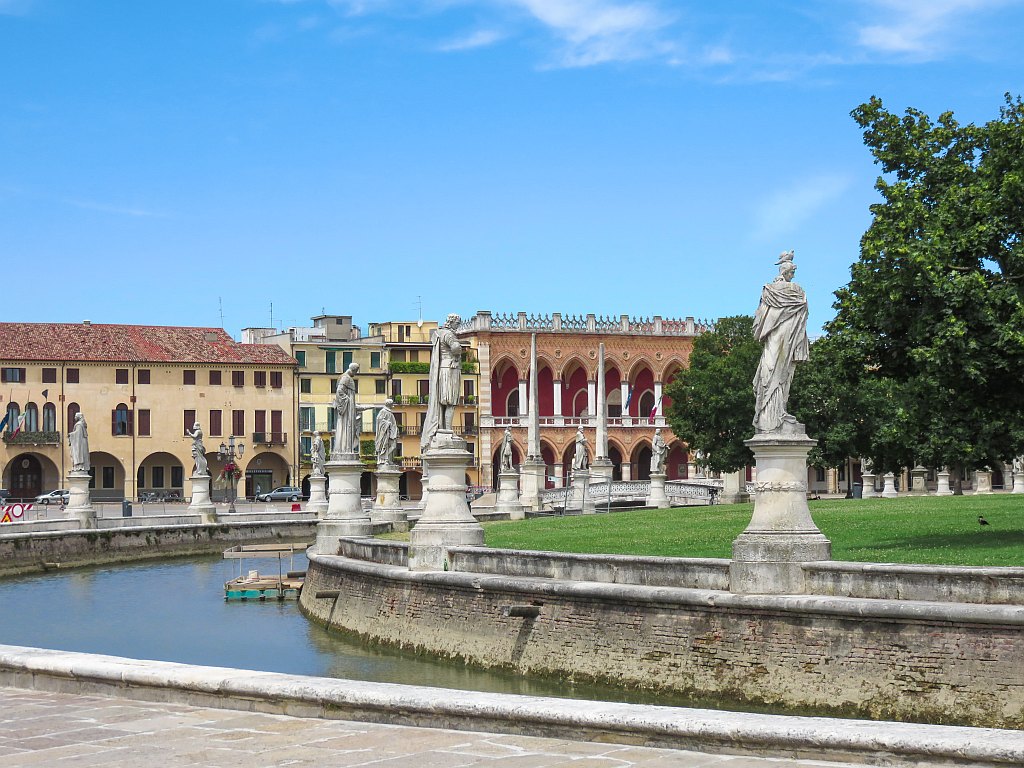
The square was designed at the end of the 18th century by the architect Andrea Memmo. Until the 1990s it was largely neglected but today is one of the most famous attractions in Padua.
9. Count the stars at La Specola
La Specola is an astronomical observatory turned into a museum. It’s housed in the tower of the Carrarese Castle, built in the 14th century by Francesco I da Carrara. In 1767 the tower was transformed into an astronomical observatory and it functioned as such until the 1930s.
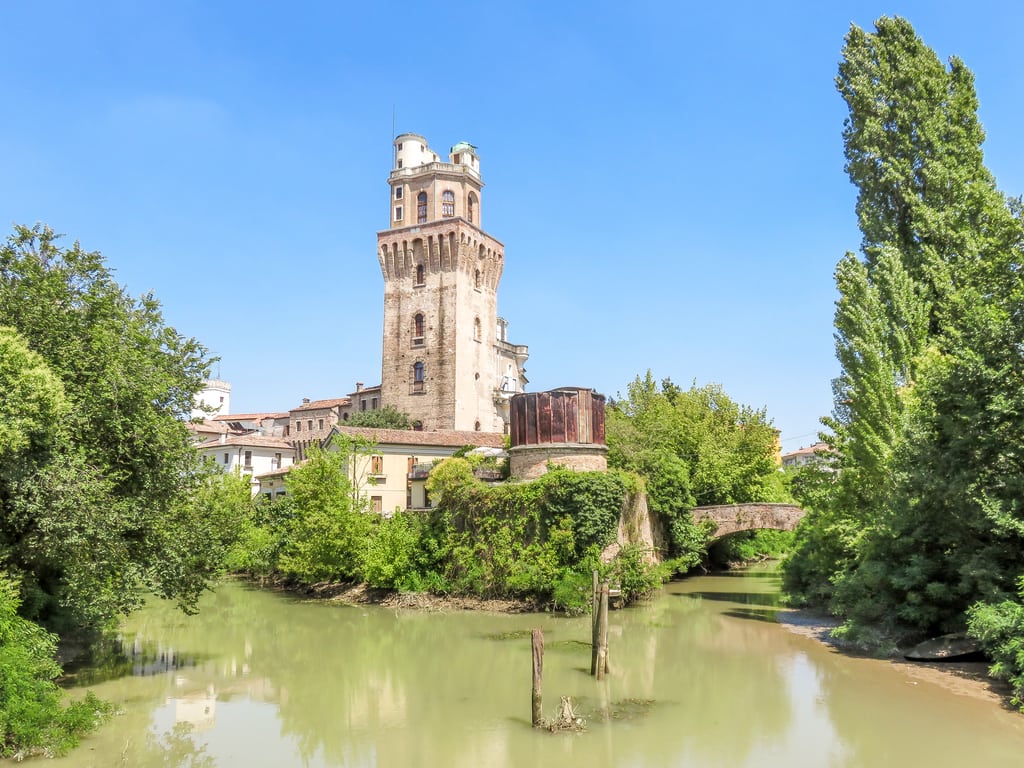
Today, you can visit the museum and see historical instruments used in past. In the so-called Figures Room you can see life-size paintings of some of the most famous historical figures in the field of astronomy: Ptolemy, Copernicus, Tycho Brahe, Galileo, Kepler, Newton, Montanari and Poleni.
When I visited the museum, it was possible to just walk in without a guided tour. This however has changed and currently the museum can be visited only with a guided tour.
Practical info
Address: Vicolo dell’Osservatorio, 5, 35122 Padova
Admission fee: adults – 8 EUR, family ticket (2 adults and 3 kids up to 14 yoa) – 20 EUR
Opening times: May-September: weekends and public holidays at 6 pm, Tuesday-Sunday, 10 am till 1 pm and from 2 pm till 6 pm
Website: www.beniculturali.inaf.it
10. Indulge in some shopping in Padua
Padua is a city that offers not only a fine combination of art, history and culture, but also a whole lot of shops, scattered around the historical center. Walking the arcaded streets of Padua from one shop to the other is a lovely way to spend your afternoon in the city.
You can also book a special shopping tour with sightseeing in Padua.
11. Cruise the Brenta Canal with Il Burchiello
If you happen to be in Padua between March and October you should go on a boat trip on the Brenta canal, that’s gonna take you past majestic villas straight to Venice. The trip is inclusive of a visit to 3 villas (Villa Pisani, Villa Widmann and Villa Foscari, aka the Malcontenta) and you can opt for a lunch.
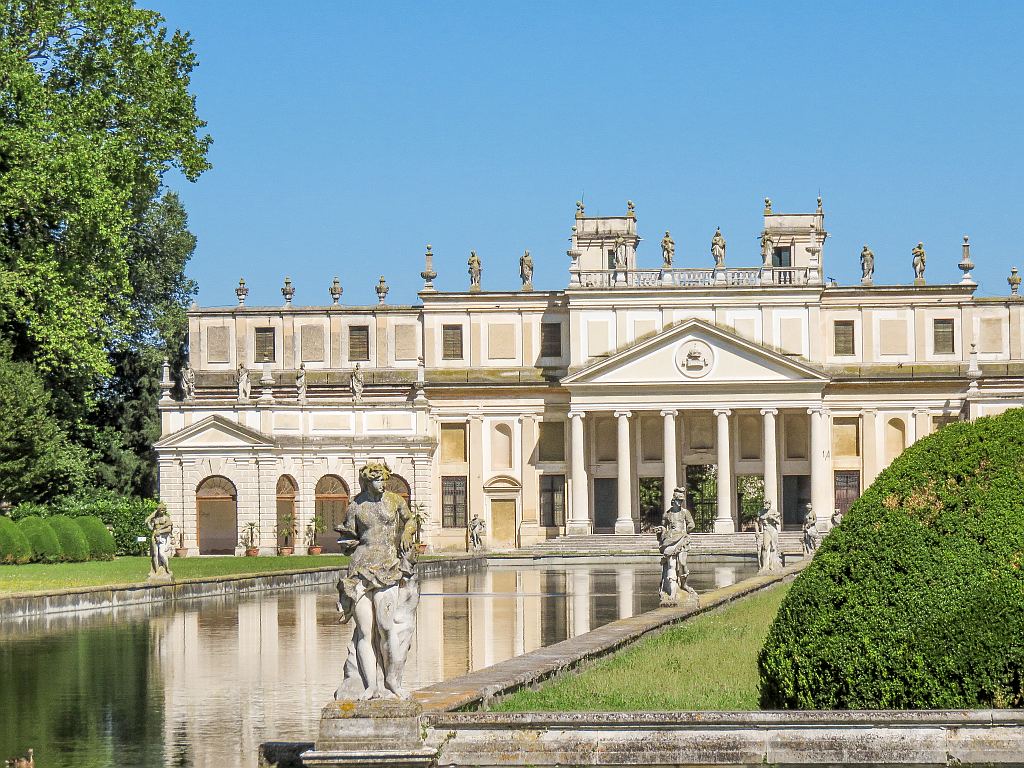
The villas along the Brenta canal were the summer residences of the wealthy and were built throughout the 16th, 17th and the 18th centuries. You can spot frescoes of Veronese or Tiepolo and enjoy the Vitruvian beauty of the Palladio’s architectural genius. The Paladian Malcontenta is another masterpiece on the List of UNESCO World Heritage Sites.
Read more: Everything you need to know about the Brenta Canal cruise.
The trip ends in Venice and what a marvelous way to arrive in the city than by water!
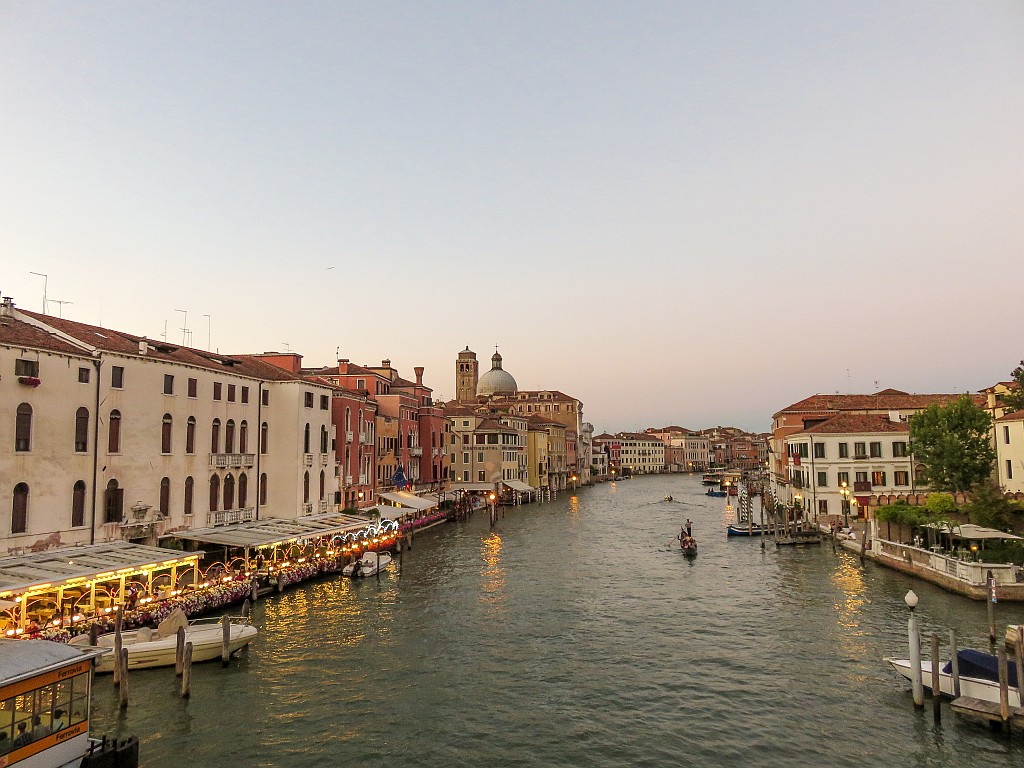
After spending some time in Venice you can go back to Padua by train. There’s a train each 20 minutes from Santa Lucia train station and it takes about 25 minutes from Venice to Padua.
12. Visit Palazzo Zuckermann and its 2 museums
Palazzo Zuckerman was built at the beginning of the 20th century for the rich industrialist Enrico Zuckermann. Zuckermann was the owner of La Zedapa – a plant for metal parts. In the second half of the 20th century it was used as the Post Office of Padua.
Today, on the first floor of the palace is housed the Museum of Applied and Decorative Arts (Museo di Arti Applicate e Decorative) and on the second one the Bottacin Museum (Museo Bottacin).

In the Museum of Applied and Decorative Arts you can find a lovely collection of 16th-century majolica, furniture from the 17th and 18th c., clothing accessories and historical clothing, and last but not least a large jewellery collection.
The Bottacin Museum on the other hand, houses the art and numismatic collection of the wealthy merchant Nicola Bottacin, who left it to the city of Padua in 1865. On display are paintings, furniture, sculptures, ancient weapons and other works acquired for the decoration of his home, built in the eclectic style of the 19th century.
Practical info
Address: corso Garibaldi, 33, 35122 Padova
Admission fee: adults – 11 EUR, kids (up to 5 yoa) – free of charge. The price includes also a visit to the Museo Eremitani. Tickets are sold only at Museo Eremitani.
Opening times: Tuesday-Sunday, 10 am till 7 pm
Website: padovamusei.it
13. See the treasures kept at the Eremitani Museums
Padua Civic Museums (Musei Civici di Padova) or The Eremitani Museums (Musei degli Eremitani) is a complex of museums and sites that besides the Palazzo Zuckermann’s museums and the Scrovegni Chapel, also includes the Archeological Museum and the Art Gallery located at the former Eremitani convent. The Eremitani were Augustinian hermit friars who came to Padua in 1237. The convent was closed in 1806 when the Napoleonic rule banned the friars.
The Archeological Museum display the long history of the city of Padua from its origins (9th-8th century BC) to late antiquity (4th century AD). There’s also a rich collection of Egyptian finds, Etruscan, Greek and Magna Graecia ceramics.
The Art Gallery or the Museum of Medieval and Modern Art, as the full name is, offers an overview of Venetian paintings and sculptures from the 14th to the 18th century. You can see there works by Giovanni da Bologna, Jacopo Bellini, Girolamo Romano, Paolo Veronese, Giorgione, and Antonio Canova among others.
Practical info
Address: piazza Eremitani 8, 35122 Padova
Admission fee: adults – 11 EUR, kids (up to 5 yoa) – free of charge. The price includes also a visit to the Palazzo Zuckermann’s 2 museums.
Opening times: daily, 9 am till 7 pm
Website: padovamusei.it
14. See the Church of the Eremitani
A part of the Eremitani convent complex is the Church of the Eremitani (Chiesa degli Eremitan). It was built between 1260 and 1276 and was dedicated to St. Philip and St. James. During WW2 the church was heavily bombed by the Allied forces and it suffered an immense destruction which was fatal for the magnificent frescoes in the Ovetari Chapel.

In 2021 the remaining frescoes in the church received a recognition by UNESCO and together with 7 other sites in Padua, among which also the Scrovegni Chapel, they were included on the List of World Heritage Sites as Padua’s fourteenth-century fresco cycles.
The church can be visited free of charge and is located next to the Museum of the Eremitani and the Scrovegni Chapel.
15. Marvel Palazzo della Ragione
Palazzo della Ragione is another famous attraction in Padua, located between the two market squares Piazza delle Erbe and Piazza dei Fruti. Besides the oldest covered, still functioning market in Europe on the ground floor, on the 2nd floor of the building you can find some amazing frescoes, which are one of the 8 UNESCO World Heritage Sites in Padua collectively known as Padua’s fourteenth-century fresco cycles. The upper floor of Palazzo della Ragione is a large hall, which served as a court room, perhaps being the largest court room in Europe.
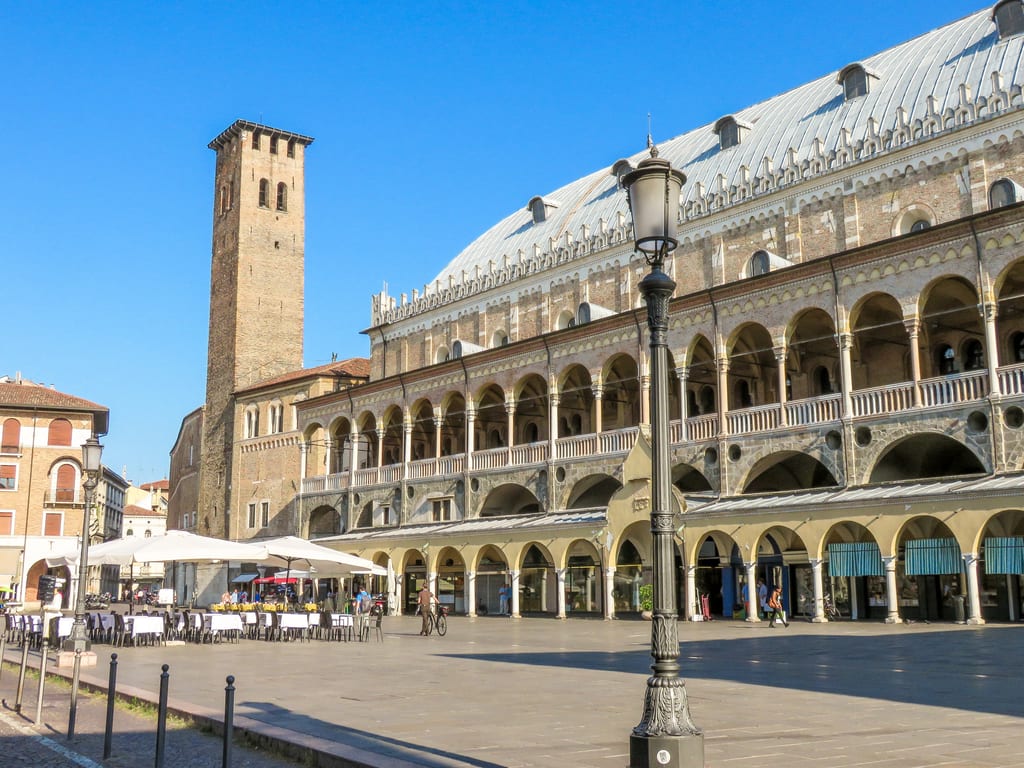
The palace was built in the early 13th century and at the beginning of the 14th century the inner walls were taken down and a new roof in the shape of an overturned ship’s hull was placed. The frescoes are made by Nicolò Miretto and Stefano da Ferrara.
Practical info
Address: Piazza delle Erbe, 35100 Padova
Admission fee: adults – 8 EUR, kids (up to 5 yoa) – free of charge.
Opening times: Tuesday-Sunday, 9 am till 7 pm
Website: padovamusei.it
16. Visit the Basilica of St. Giustina
Located at one corner of Prato della Valle, this beautiful church is another famous landmark in Padua. Actually, Prato della Valle belonged to the Abbey of St. Giustina until 1767, of which the Basilica of St. Guistina is a part. The basilica was first built in the 6th century, but it got its present look in the 17th century when it was substantially renovated. St. Justina of Padua (4th century), together with St. Anthony of Padua (12th-13th century), is one of the patron saints of the city.

The Abbey of St. Giustina itself emerged in the 9th century as a Benedictine abbey. The abbey was closed after Napoleon invaded Padua in 1797. The buildings were returned to the Catholic Church at the beginning of the 20th century.
My tip is to enjoy a drink at Prato della Valle overlooking the beautiful basilica church.
Address: Via Giuseppe Ferrari, 2/A, 35123 Padova
17. Enjoy a cup of coffee and a lesson in history at Pedrocchi Café
Pedrocchi Café (Caffè Pedrocchi) is one of the most emblematic places in Padua. A coffee house was founded in 1772 by Francesco Pedrocchi and in 1831 the café as we know it today opened. Soon it became one of the most beloved meeting places for writers and artists. Among the most prominent guests that frequented the café were Lord Byron, Stendhal and Dario Fo.
The fame however of Pedrocchi Café came in 1848 when the café was connected with student riots against the Habsburg Monarchy.

You can book a walking tour of Padua with a visit of the Pedrocchi Café and a cup of coffee there.
The Pedrocchi Café is also home to the Museum of the Risorgimento (Museo del Risorgimento e dell’Età Contemporanea) dedicated to the history of Padua from the fall of the Venetian Republic (1797) to the promulgation of the Italian Constitution on January 1, 1948.
Address (café): Via VIII Febbraio, 15, 35122 Padova
Practical info for the Museum
Address: Piazzetta Cappellato Pedrocchi, 35122 Padova
Admission fee: adults – 5 EUR, kids (up to 5 yoa) – free of charge.
Opening times: Tuesday-Sunday, 9:30 – 12:30 am, 3:30 – 6 pm
Website: padovamusei.it
18. Get a sense of Padua as a university city at Palazzo Bo
Padua prouds itself in being home to the 2nd oldest university in Europe and the world’s 5th-oldest university. The University of Padua was established in 1222 and Bo Palace (Palazzo Bo) has been the historical seat of the university since 1493. The Bo Palace is also home to the oldest anatomical theater in the world.
You can visit Palace Bo with a guided tour, where you can see the Anatomical Kitchen, the Anatomical Theater, the Galileo Galilei Great Hall (l’Aula Magna Galileo Galilei), the Hall of Forty (la Sala dei Quaranta), the Hall of Medicine (la Sala di Medicina), and the Hall of Law (Sala di Giurisprudenza).
Practical info
Address: Via VIII Febbraio, 2, 35122 Padova
Website (tours and times): www.unipd.it

Thank you, Madam ! Padua an unknown romantic town !”
“Oh let the skies thy worthy mirror be!
And in dear stars thy shape and image see…”
Indeed it’s a magical city!
So nice seeing in your post Padova!
II’ve been there many times, as I live quite close. I really liked your post and your photos 🙂
Thank you! I fell in love with Padua…
Love places that are void of jammed pack tourists so Padua looks like a nice place to visit. Interesting the Il Duomo is still unfinished. But it’s great that it’s close to Venice too because even though it’s crowded, it’s still worth visiting.
Padua looks like a hidden Italian gem that gives such happy feels. I’ve planned a day trip to Venice in August and am considering exploring more of Padua now, all thanks to you! Would love to see the Duomo Cathedral which hasn’t been completed yet!
Thank you for exposing this hidden gem! Padua looks like an amazing pace to visit and I can’t wait to add it to my itinerary
Sounds like an amazing place!
Wonderful post! Makes me wistful. I was in Padua a number of years ago, but it was just a one day stopover between two other cities. I would have loved to get to explore more of the town like you did. I love the idea of “home-basing” in a smaller town like this that is easy commuting distance to the big touristy ones. Great idea!
It looks like a very interesting city to visit, specially if we follow your recommendations.
I loved the Giotto’s masterpiece too. It’s so beautiful !!
Cheers
I’m heading to Venice in September! I only have a few days unfortunately, but I can’t wait to squeeze as much as I can in. I’m so excited to explore Italy!
Leah
I’d never heard of this place but it looks really beautiful. I love discovering places that not everyone goes to!
Yep, Padua is one of these. I love also discovering new places – like everybody knows Rome, Venice & Florence, that even without actually being there, you feel like you’ve already been – there’s so much exposure everywhere. I’m happy I can inspire people to discover new places.
Beautiful pictures and what a fun itinerary. We are going to Venice this summer and almost stayed in Padua! Unfortunately, we didn’t have enough time to explore both cities so we’re just staying in Venice. Hope to see Padua one day.
Enjoy Venice!
Nice tips ! And of course Vinnies is a must go ;))) I like your photography by the way !
Thanks Anna!
Great post! I’ve been to Italy many times, but not to Padua. I didn’t realise it was such a lovely city! It’s on my list for next time. I can’t believe the cathedral is still not finished though!
Yes, Padua is a hidden gem!
Padua looks so beautiful! This article really inspired me to travel there one day.
You should absolutely visit it! There’s so much to do and see there!
I can imagine, I have traveled in Italy quite a bit with my family back when I was a child, but I´d love to see it again with different eyes! 🙂
One and the same place can be so different of you are 15 or 35 or 55!
Exactly 🙂 we change, but places change as well…
Padua sounds great! Perfect to stay in a cute little town away from the tourists and still be close to Venice for a day trip! Definitely an off the beaten path destination. 😉
Yes, in a place like this you can “taste” the Italian way!